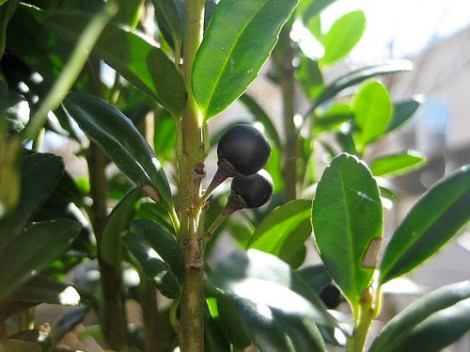
By Julie Christensen
Few landscaping plants are as versatile as Japanese holly (Ilex crenata). This shrub is an evergreen holly, with dark green, finely textured leaves, white flowers and black or purple fruit. The shrub is not native to the U.S., but is widely used in foundation plantings or mixed beds. Japanese holly is recommended for U.S.D.A. plant hardiness zones 6-8.
Getting Started
Japanese holly is propagated from cuttings and most gardeners start with plants purchased at a nursery. For best flowering and compact growth, plant Japanese Holly in full sun. In shade, it can become leggy. Japanese holly prefers a slightly acidic soil, although it tolerates a neutral to slightly alkaline pH.
If you live in a cold climate, plant Japanese holly in a protected area, such as near a house or amongst larger trees and shrubs. Amend the soil with plenty of compost, manure and peat moss to improve drainage. Peat moss also lowers the soil pH slightly if your soil is alkaline.
Water frequently to keep the soil moist, but not soggy. An organic mulch, such as bark or wood chips, is a good idea to conserve moisture and keep weed growth down. Mulches also protect the roots from injury in the winter. Spread no more than 2 to 4 inches of wood chip mulch on the ground around the plants.
Don’t forget to water Japanese holly in late fall and again throughout the winter during dry weather. In the winter, water anytime the ground is bare and there has been no rainfall or snow melt. Water when day time temperatures are above 45 degrees. In cold areas, wrap the shrubs with burlap to prevent winter burn. Remove the burlap as soon as temperatures start to warm in the spring.
Japanese hollies don’t need frequent pruning, but they tolerate severe pruning if you want a compact form or trimmed hedge look. Cut the shrubs back to lateral tips in late winter or early spring.
Japanese Holly Pests and Disease
Unfortunately, for all their positive attributes, Japanese hollies are subject to many pests and diseases. Your best defense, of course, is a good offense. Buy disease-resistant varieties and keep Japanese hollies healthy so they’re better able to fend off problems, which include:
- Leafminers. These pests are actually the larva of gray and black flies. They burrow through leaves, causing yellow or brown patches. Remove and destroy infected leaves or treat the plants with a foliar insecticide.
- Mites. These small relatives of spiders feed on the undersides of leaves, sucking the juices and causing yellowing and leaf drop. In severe infestations, you might notice webbing on the branches and leaves. Treat with an insecticidal soap or oil and encourage natural predators, such as ladybugs and predatory mites.
- Scale. Scale insects gather in colonies and resemble small shells or scales. They have no visible legs and do not move. Scrape scales off gently and destroy them or treat the shrubs early in spring with an insecticidal oil.
- Black Root Rot is the most common disease problem in Japanese hollies. This fungal disease lives in the soil for many years and there is no cure for infected plants. Black root rot causes yellowing and dieback. If you dig up the shrub, you’ll observe blackened roots. Remove infected plants and replace them with something other than Japanese hollies.
- Phytophthora Root Rot causes symptoms similar to black root rot, but it can be prevented through good cultural practices. Ensure that the soil drains well because heavy, soggy soils promote this disease. Plant Japanese hollies in raised beds if necessary. Keep the soil moist, but not wet, and place plants where they receive full sun.
Varieties
Japanese hollies range in size from 3 feet to 10 feet tall, depending on the variety. They resemble boxwoods, with their small, shiny leaves. Unlike other hollies, Japanese hollies have no spines. Below are a few to consider:
- ‘Convexa’ grows 10 feet tall and 24 feet wide, making this the largest Japanese holly.
- ‘Helleri’ is a compact, rounded form that grows 3 feet tall. It is often used in mass plantings.
- ‘Roundleaf’ grows 5 to 10 feet tall and does not produce fruit.
To learn more about holly, visit the following sites:
Holly by Clemson University
Black Root Rot of Japanese Holly by Virginia Cooperative Extension
When she’s not writing about gardening, food and canning, Julie Christensen enjoys spending time in her gardens, which include perennials, vegetables and fruit trees. She’s written hundreds of gardening articles for the Gardening Channel, Garden Guides and San Francisco Gate, as well as several e-books.